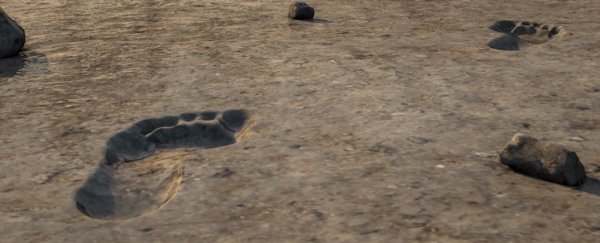Researchers have dated an ancient and incredibly rare collection of footprints on the mudflats beyond the Ol Doinyo Lengai volcano in Tanzania. There are more than 400 footprints at the site, thought to have been left between 5,800 and 19,100 years ago.
By knowing more about when these ancient footprints were committed to the dirt near the village of Engare Sero, it gives scientists a unique opportunity to figure out how these early African Homo sapiens might have lived and travelled.
Some of the tracks imply that people were moving at a brisk jogging speed, while others show groups of women and children travelling together. One person appears to have been walking with a broken big toe.
"The first time we went out there, I remember getting out of the vehicle, and I teared up a little bit," geologist and lead researcher Cynthia Liutkus-Pierce, from Appalachian State University, told Michael Greshko at National Geographic.
"Human origins is a huge interest of mine: where we came from, and why we are who we are. It was definitely emotional to see our own history in this."
Scientists were first alerted to the Engare Sero site back in 2008, but have just published their findings after years of careful research to date and explain these prints.
They think that mud flowing down from the 2,332-metre-tall (7,650-foot) Ol Doinyo Lengai volcano formed the Engare Sero mudflats, and in the days before it dried, it managed to capture and preserve these ancient tracks.
But they might not have always been visible - the researchers suggest that the site was covered with another flow of debris from the volcano 10,000 to 12,000 years ago.
Originally, the scientists thought the mud was formed directly from an ash cloud, which would date the prints at around 120,000 years old. Now, the hypothesis is that the ash was carried down by water, which means the footprints probably aren't quite so ancient.
By identifying the youngest crystals buried in the mud using geochronological techniques, the team found the tracks could have been deposited as far back as 19,100 years ago, with a margin of error of a few thousand years.
Now that the timeframe has been narrowed, the researchers want to move on to studying more about how these people lived and socialised. There are still plenty of mysteries left to solve.
"It's a very complicated site," one of the team, William Harcourt-Smith from the City University of New York, told National Geographic. "There's one area where there are so many prints, we've nicknamed it the 'dance hall', because I've never seen so many prints in one place. It's completely nuts."
The site that claims to have the oldest footprints ever discovered is Laetoli, also in Tanzania, which is dated to around 3.6 million years ago. But those tracks would have been left by earlier human ancestors, members of the Australopithecus afarensis species, and there is some debate about the interpretation of the site.
Meanwhile, the research at Engare Sero is set to continue, so we can discover more about who these ancient people were.
The site has been wired off with a fence to help protect these ancient tracks, but the excitement around the discovery means it's turned into something of a tourist attraction, if you want to go and take a look yourself…
To find out more about the footprints, you can watch a visualisation of the event made by CG environment artist Katie Hill, who graduated from Bournemouth University and was not involved in the new study.
The findings have been reported in Palaeogeography, Palaeoclimatology, Palaeoecology.
